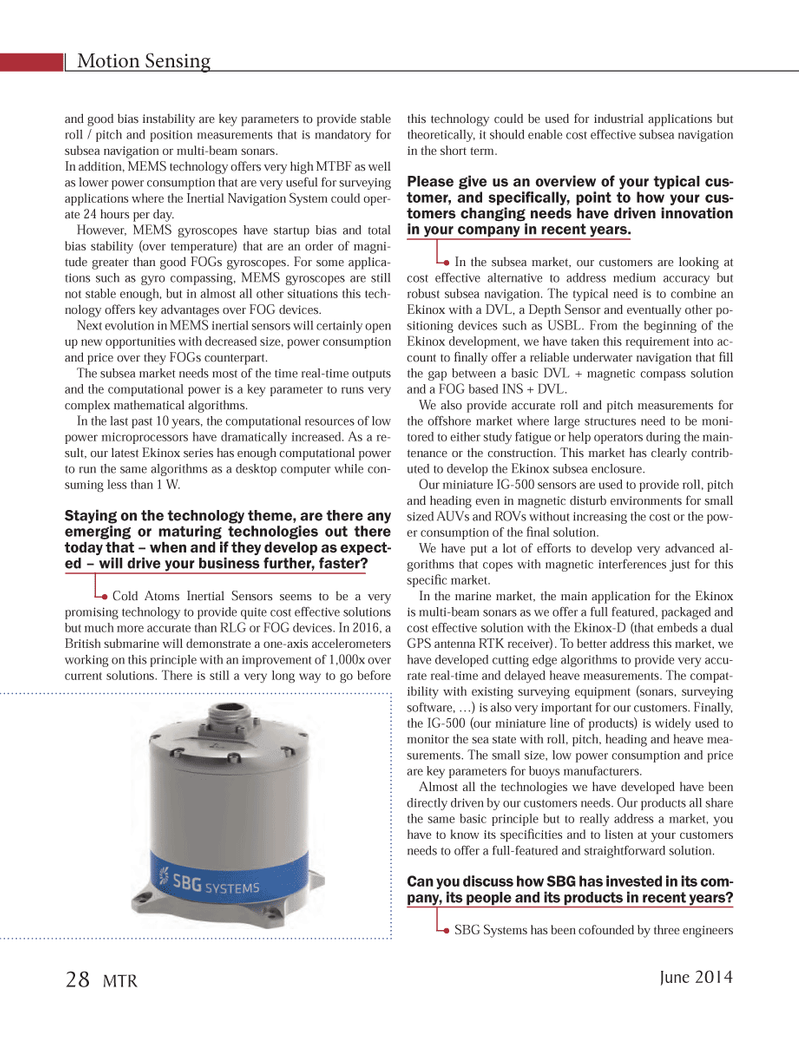
Page 28: of Marine Technology Magazine (June 2014)
Hydrographic Survey
Read this page in Pdf, Flash or Html5 edition of June 2014 Marine Technology Magazine
Motion Sensing and good bias instability are key parameters to provide stable roll / pitch and position measurements that is mandatory for subsea navigation or multi-beam sonars.
In addition, MEMS technology offers very high MTBF as well as lower power consumption that are very useful for surveying applications where the Inertial Navigation System could oper- ate 24 hours per day.
However, MEMS gyroscopes have startup bias and total bias stability (over temperature) that are an order of magni- tude greater than good FOGs gyroscopes. For some applica- tions such as gyro compassing, MEMS gyroscopes are still not stable enough, but in almost all other situations this tech- nology offers key advantages over FOG devices.
Next evolution in MEMS inertial sensors will certainly open up new opportunities with decreased size, power consumption and price over they FOGs counterpart.
The subsea market needs most of the time real-time outputs and the computational power is a key parameter to runs very complex mathematical algorithms.
In the last past 10 years, the computational resources of low power microprocessors have dramatically increased. As a re- sult, our latest Ekinox series has enough computational power to run the same algorithms as a desktop computer while con- suming less than 1 W.
Staying on the technology theme, are there any emerging or maturing technologies out there today that – when and if they develop as expect- ed – will drive your business further, faster? Cold Atoms Inertial Sensors seems to be a very promising technology to provide quite cost effective solutions but much more accurate than RLG or FOG devices. In 2016, a
British submarine will demonstrate a one-axis accelerometers working on this principle with an improvement of 1,000x over current solutions. There is still a very long way to go before this technology could be used for industrial applications but theoretically, it should enable cost effective subsea navigation in the short term.
Please give us an overview of your typical cus- tomer, and specifi cally, point to how your cus- tomers changing needs have driven innovation in your company in recent years. In the subsea market, our customers are looking at cost effective alternative to address medium accuracy but robust subsea navigation. The typical need is to combine an
Ekinox with a DVL, a Depth Sensor and eventually other po- sitioning devices such as USBL. From the beginning of the
Ekinox development, we have taken this requirement into ac- count to fi nally offer a reliable underwater navigation that fi ll the gap between a basic DVL + magnetic compass solution and a FOG based INS + DVL.
We also provide accurate roll and pitch measurements for the offshore market where large structures need to be moni- tored to either study fatigue or help operators during the main- tenance or the construction. This market has clearly contrib- uted to develop the Ekinox subsea enclosure.
Our miniature IG-500 sensors are used to provide roll, pitch and heading even in magnetic disturb environments for small sized AUVs and ROVs without increasing the cost or the pow- er consumption of the fi nal solution.
We have put a lot of efforts to develop very advanced al- gorithms that copes with magnetic interferences just for this specifi c market.
In the marine market, the main application for the Ekinox is multi-beam sonars as we offer a full featured, packaged and cost effective solution with the Ekinox-D (that embeds a dual
GPS antenna RTK receiver). To better address this market, we have developed cutting edge algorithms to provide very accu- rate real-time and delayed heave measurements. The compat- ibility with existing surveying equipment (sonars, surveying software, …) is also very important for our customers. Finally, the IG-500 (our miniature line of products) is widely used to monitor the sea state with roll, pitch, heading and heave mea- surements. The small size, low power consumption and price are key parameters for buoys manufacturers.
Almost all the technologies we have developed have been directly driven by our customers needs. Our products all share the same basic principle but to really address a market, you have to know its specifi cities and to listen at your customers needs to offer a full-featured and straightforward solution.
Can you discuss how SBG has invested in its com- pany, its people and its products in recent years? SBG Systems has been cofounded by three engineers 28 MTR
June 2014
MTR #5 (18-33).indd 28 6/9/2014 10:21:46 AM

 27
27

 29
29
